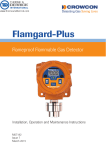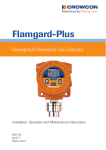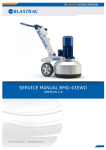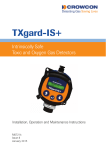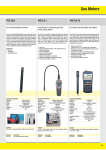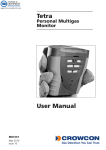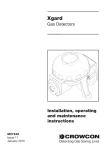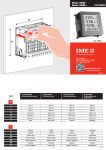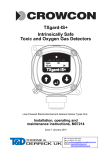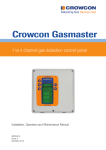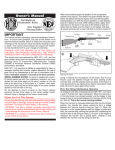Download Crowcon TXgard Plus Fixed Gas Detector User Manual DOWNLOAD
Transcript
TXgard-Plus Flameproof Toxic and Oxygen Gas Detector with Non-intrusive One-man Calibration Installation, Operation and Maintenance Instructions M07194 Issue 5 March 2015 TXgard-PlusIntroduction 1 Introduction 1.1 Product overview TXgard-Plus is a flameproof toxic and oxygen gas detector suitable for use in zone 1 or 2 hazardous areas. It is designed to detect toxic gases and oxygen using a range of electrochemical sensors. A local display and magnetically operated switches allow non-intrusive one-man calibration without a hot work permit. Powered by 24 V dc (nominally) TXgardPlus provides a 4-20 mA signal (sink or source) proportional to the gas concentration and can also be fitted with optional alarm and fault relays. For a list of gases that can be detected, please contact Crowcon. 1.2 Product description TXgard-Plus comprises four parts; 96HD sensor housing, junction box, amplifier and terminal board. Diagram 1 details Txgard-Plus. The overall assembly is certified Ex d IIC T6 in Europe and Class 1, Zones 1&2 AEx d IIC T6 in the USA. The 96HD sensor housing is a modular stainless steel assembly that dismantles to allow plug in sensors to be replaced easily (see Diagram 4). The assembly screws into an M20 entry on the junction box. The junction box is manufactured from marine grade alloy and is supplied with 2 x M20 (1/2” NPT for USA) cable entries for customer use. Alternative cable entries are available from Crowcon. The amplifier plugs into the terminal board, and is held in place by two captive screws. The amplifier provides power to the sensor, local display and controls, and a 4-20 mA signal proportional to the gas concentration for connection to a control panel. To remove, turn screws anti-clockwise and use them to pull amplifier out of the enclosure. All electrical connections are made via the terminal board mounted in the base of the junction box (see Diagram 2). Optional alarm relays (AL1 & AL2) and one fault relay (FAULT) are mounted on the terminal board which may be used to drive local warning devices or connect TXgardPlus to a control panel. 1 IntroductionTXgard-Plus 1.3 Status Indication TXgard-Plus includes a local display and status LED, visible through the junction box window, see Diagram 1. The display shows the gas concentration and current mode of operation ie. NORMAL, ZERO or CAL. The LED shows the current alarm state of the detector. This is summarised in Table 1. Operational state LED indication Normal operation Steady green AL1 - Off AL2 - Off FAULT - On Gas level < AL1 Current output = 4-20 mA Normal operation (ALARM 1) Steady red AL1 - On AL2 - Off FAULT - On Gas level > AL1 < AL2 Current output = 4-20 mA Normal operation (ALARM 2) Flashing red AL1 - On AL2 - On FAULT - On Gas level > AL2 Current output = 4-20 mA Over-range Flashing red AL1 - On AL2 - On FAULT - On Gas level > full scale Display backlight flashes Current output = 24 mA Zero/ calibration mode Flashing green Configuration dependent (see section 2) Latched until reset via 'MENU' Current output = 2 mA 4 mA option) AL1 - Off AL2 - Off FAULT - Off Current output = 0 mA Detector fault Steady amber Relay states* *See section 2 for AL1 and AL2 standard settings = Relay version only Table 1: LED status indicator summary. 2 Comment* TXgard-PlusIntroduction 1 115 (4 /2") UNITS TAMPER PROOF GRUB SCREW (1.5mm ALLEN KEY) 1 M20 ( /2"NTP) CABLE ENTRY LOCAL DISPLAY M20 (½" NTP) CABLE ENTRY FLASHING INDICATES 4-20mA/RELAYS INHIBITED ALARM 1 & 2 ADJUSTMENT POTS TXgard-Plus 135(55/16") LEL ZERO CAL INHIBIT STATUS Menu 200 (8") STEADY ON INDICATES ZERO/CAL MODE ACTIVATED STATUS LED SN: "DOWN" "UP" EXTERNAL EARTH POINT 4 OFF FIXING HOLES Ø6mm (¼") 83 (3¼") 1 HEIGHT = 115 (4 /2") All dimmensions in mm unless otherwise stated Diagram 1: TXgard Plus general arrangement 3 IntroductionTXgard-Plus REAR VIEW OF AMPLIFIER GAS RANGE ALARM SR OUTPUT SK - 4mA TEST + POINT 40-200mV OUTPUT OPTIONS INHIBIT N Y 17 4 2 RELAY CONTACT CONTACT REVERSING LINKS 12 ALARM 11 10 9 8 7 ALARM1 RL1 RL2 ALARM 1 FAULT ALARM1 FAULT NC NO NC NO GND RL3 ISOLATE 0V USED FOR OXYGEN TXGARD FOR TOXIC LINK SET TO OTHER NO NC ALARM 2 GND ISOLATE LINK ALARM SET POTS OXYGEN OTHER ALARM 2 1 0V 2 10-30V 3 CONTROL EQUIPMENT 4-20mA 4 5 6 SENSOR TO 96HD SENSOR INTERNAL TERMINAL LAYOUT = ALARM RELAY VERSION ONLY Diagram 2: Terminal and amplifier layouts 4 TXgard-Plus Detector configuration 2. Detector configuration 2.1 Standard configuration As standard, TXgard-Plus is factory set as follows: Current source with AL1 relay 0 mA = Fault 2 mA = Inhibit ie. Zero/Cal mode 4-20 mA = Normal operation 24 mA = Over-range clamp Alarm level 1, see Table 3 Normally de-energised, energising on alarm AL2 relay Contact normally open (NO), closing on alarm Alarm level 2, see Table 3 Normally de-energised, energising on alarm FAULT relay Contact normally open (NO), closing on alarm Normally energised, de-energised on fault Contact normally closed (NC), opening on fault Alarm/fault relays automatically reset when alarm or fault has cleared. INHIBIT Normally selected, ie. when CAL/ZERO selected current output is forced to 2mA and relays are held in normal/no alarm state. Table 2: Standard configuration for TXgard-Plus. 5 Detector configurationTXgard-Plus Table 3 details standard alarm points for the available gases and ranges. Gas Range* AL1* AL2* Hydrogen sulphide 0-25 ppm 5 ppm 10 ppm Carbon monoxide 0-250 ppm 30 ppm 200 ppm Oxygen 0-25% vv 19% vv 17% vv *Alternative ranges and alarm set points must be specified when ordering Table 3: Standard ranges and alarm set points. Location of links are shown in Diagram 2. 2.2 4-20mA options To change current source output to sink, set switch to ‘SK’ position. To change Inhibit from 2 mA to 4 mA, fit link to ‘4’ position. 2.3 Relay options To change AL1 or AL2 relay from NO to NC, fit link in the ‘NC’ position. To change FAULT relay from NC to NO, fit link in the “NO” position. 2.4 Inhibit options To not inhibit 4-20 mA signal and relays, fit link to ‘N’ and link to ‘4’. 6 TXgard-PlusInstallation 3. Installation WARNING TXgard-Plus is designed for use in Zone 1 and 2 hazardous areas and is certified Ex d IIC T6 (AEx d IIC T6 in USA). Installation must be in accordance with the recognised standards of the appropriate authority in the country concerned. For more information contact Crowcon. Prior to carrying out any work ensure local regulations and site procedures are followed. 3.1 Location There are no rules which dictate the siting and location of detectors, however, considerable guidance is available from BS EN 50073:1999 ‘British Standard Code of Practice for the Selection, Installation, Use and Maintenance of Apparatus for the Detection and Measurement of Combustible Gases or Oxygen.’ In the USA refer to the National Electrical Code (NEC 1999). Similar international codes of practice may be used where applicable. In addition certain regulatory bodies publish specifications giving minimum gas detection requirements for specific applications. The detector should be mounted where the gas is most likely to be present. The following points should be noted when locating gas detectors: • To detect gases which are lighter than air, detectors should be mounted at high level and Crowcon recommend the use of a collector cone (Part No. C01051). • To detect heavier than air gases (eg hydrogen sulphide), detectors should be mounted at low level. • When locating detectors consider the possible damage caused by natural events e.g. rain or flooding. For detectors mounted outdoors Crowcon recommend the use of a Weatherproof Cap (Part No. C01442). • Consider ease of access for functional testing and servicing. • Consider how the escaping gas may behave due to natural or forced air currents. Mount detectors in ventilation ducts if appropriate. 7 InstallationTXgard-Plus • Consider the process conditions (ie whether gas within a process is at high temperature or high pressure) Detector placement should be determined following advice of experts having specialist knowledge of gas dispersion, the plant processing equipment as well as safety and engineering issues. The agreement reached on the locations of sensors should be recorded. 3.2 Mounting The mounting detail of TXgard-Plus is given in Diagram 1. TXgardPlus should be installed at the designated location with the detector pointing down. This ensures that dust or water will not collect on the sinter and stop gas entering the detector. 3.3 Cabling requirement Cabling to TXgard-Plus must be in accordance with the recognised standards of the appropriate authority in the country concerned and meet the electrical requirements of the detector. Crowcon recommend the use of steel wire armoured (SWA) cable and suitable explosion proof glands must be used. Alternative cabling techniques, such as steel conduit, may be acceptable provided appropriate standards are met. TXgard-Plus requires a dc supply of 12-30 V at up to 100 mA. Ensure the minimum dc supply of 12 V is observed at the detector, taking into account the voltage drop due to cable resistance. For example, a nominal dc supply at the control panel of 24 V has a guaranteed minimum supply of 20V. The maximum voltage drop allowed is therefore 8V. TXgard-Plus can demand up to 100 mA and so the maximum loop resistance allowed is 80 Ohms. A 1.0 mm2 cable will typically allow cable runs up to 2000m. Table 4 shows maximum cable distances given typical cable parameters. 8 TXgard-PlusInstallation CSA Resistance (Ohms per km) Max. distance mm2 (awg) Cable Loop m (ft) 1.0 (17) 18.1 36.2 1000 (3280) 1.5 (15) 12.1 24.2 1500 (4920) Table 4: Maximum cable distances for typical cables Acceptable cross sectional area of cable is 0.5 to 1.5 mm2. Table 2 provides guidance only, actual cable parameters for each application should be used to calculate maximum cable distances. 3.4 Electrical connections All connections are made via the terminal board mounted in the base of the junction box (see Diagram 2). The 3 wires from the 96HD are colour coded and should be terminated in the corresponding colour coded terminal (terminals 4, 5 & 6). Terminals 1 (0 Vdc), 2 (12-30 Vdc) and 3 (4-20mA signal) are connected to the control equipment. TXgard Plus is factory set as a 4-20 mA sink device unless specified otherwise when ordering (see Section 2 to change configuration). Diagram 3 summarises the electrical connections. Note: The junction box and cable armour must be earthed at the detector or control panel to limit the effect of radio frequency interference and to maintain electrical safety. Note: The junction box for the TXgard Plus is manufactured from marine-grade alloy, and has a powder-coated finish. Care should be taken during installation to protect the painted finish, as use in saline environments could result in paint flaking off from damaged junction boxes. This in no way compromises the performance of the detector, as the marine-grade alloy junction box is approved for use in offshore environments. 9 InstallationTXgard-Plus All electrical connections to the optional relays are made via the 6-way terminal block on the terminal board in the base of the junction box (see Diagram 2). The relay contacts are rated 1 A @ 30 Vdc. CONTROL EQUIPMENT CONTROL EQUIPMENT SAFE AREA SAFE AREA TXGARD-PLUS SOURCE Diagram 3: Electrical connections to TXgard-Plus 10 TXGARD-PLUS SINK 1 0V 3 4-20mA 2 1 0V 3 4-20mA 2 12-30 V 0V +V 12-30 V 0V +V TXgard-PlusOperation 4. Operation WARNING Prior to carrying out any work ensure local regulations and site procedures are followed. Never attempt to open the detector or junction box when flammable gas is present. Ensure that the associated control panel is inhibited so as to prevent false alarms. 4.1 Commissioning Procedure a Open the junction box of the detector by loosening the tamper proof grub screw and removing the lid by rotating it anti-clockwise. b Remove the amplifier and check that all electrical connections have been made and are correct as per Diagram 3. c Replace the amplifier and close the junction box ensuring that all screws have been re-fitted correctly. d Apply power to the detector. The status LED will show a steady green indicating normal operation. e Leave the detector to stabilise for 1-2 hours. Zeroing the detector (ZERO Mode): f Place the end of ‘CRO-Mag’ over the ‘MENU’. Green Status LED will flash. Decimal point above ‘ZERO’ will illuminate. Display backlight will illuminate. Decimal point above ‘INHIBIT’ may flash if the option has been internally selected. g With no flammable gas present at the detector, place the end of the ‘CRO-Mag’ key over the ‘UP’ or ‘DOWN’ arrow pads to make the display read zero. Note: Oxygen detectors may be zeroed in fresh air. Calibrating the detector (CAL Mode): h Place the end of the ‘CRO-Mag’ over the MENU pad. The decimal point above the word CAL will illuminate. Other indications remain unchanged. i Apply calibration gas to the detector at a flow rate of 0.5 litres/min. (contact Crowcon for the supply of calibration gas.) 11 OperationTXgard-Plus j Allow the gas reading to stabilise. k Place the end of the ‘CRO-Mag’ over the ‘UP’ or ‘DOWN’ arrow pads to make the display read the correct concentration. l If the control equipment display requires adjustment consult the operating manual for the equipment. Returning to normal operation (NORMAL Mode): n Place the end of ‘CRO-Mag’ over the ‘MENU’ pad. All decimal points will disappear and the backlight will turn off. The green status LED will be on steadily (assuming no gas is present at the detector). o The detector is now operational. Note: Always return the detector to NORMAL mode to avoid leaving the detector in a permanently inhibited state. 4.2 Routine maintenance The operational life of the sensors depends on the application, frequency and amount of gas being seen. Under normal conditions (6 monthly calibration with periodic exposure to CAL gas) the life expectancy of the detectors are: • Hydrogen sulphide 18 to 36 months • Carbon monoxide 18 to 36 months • Oxygen 24 months Site practices will dictate the frequency with which detectors are tested. Crowcon recommend detectors are gas tested at least every 6 months and re-calibrated as necessary following the steps given in 4.1. 12 TXgard-PlusOperation 4.3 Sensor replacement/servicing of detectors WARNING This work should be carried out by Crowcon or an approved service centre unless suitable training has been received. TXgard-Plus uses the 96HD sensor housing which allows the user to replace the sensors, gaskets and sinter if necessary. An exploded view of the 96HD sensor housing is given in Diagram 4. The following procedure may be followed when servicing a TXgard-Plus detector. a Switch off and isolate power to the detector requiring attention. b Open the detector Junction box by loosening the tamper proof grub screw and removing the lid by rotating it anti-clockwise. c Remove the amplifier. d Disconnect the 3 sensor wires from the terminal board (terminals 4, 5 & 6). e Unscrew the complete 96HD sensor housing from the junction box. Note: If a spare 96HD sensor housing complete with new sensor is available ignore steps f to k and return the old 96HD to Crowcon or an approved service centre for repair. f Open the 96HD sensor housing by removing the four Allen head screws from the Top Cap with a 3mm Allen key. g Remove the sensor from the Top Cap PCB. h Fit the replacement sensor checking the part number is correct. This part number is labelled on the main body of the detector. i Inspect the gaskets and replace if necessary. j The sinter assembly will only need to be replaced if it has become blocked by dust or oil. Such blockage causes the response time of the detector to be slow and may affect sensitivity. To remove the sinter a removal tool (Part # M01614) is required. Loctite No 243 must be used on the sinter assembly threads to maintain certification. 13 OperationTXgard-Plus 4 OFF M4 X 12MM ALLEN HEAD SCREWS TOP CAP & SENSOR PCB NEOPRENE GASKET 1 (Part No MO4452) PELLISTOR GASKET 2 (Part No MO4128) SLEEVE MAIN BODY SINTER ASSEMBLY (Part No SO1781) SINTER Diagram 4: 96HD assembly k Re-assemble the 96HD housing taking time to ensure that the 3 mm Allen head screws are securely fixed into position. I Fit the 96HD sensor housing to the junction box ensuring that the colour coded wires are terminated correctly. mReplace amplifier ensuring the captive screws are fastened securely. n Switch on power. 14 TXgard-PlusOperation o Close the junction box remembering to fasten the tamper proof grub screw into position. p Follow the Commissioning Procedure given in 4.1. 4.4 Changing Alarm Levels (Relay Version Only) WARNING This work should be carried out by Crowcon or an approved service centre unless suitable training has been received. Before attempting to change alarm levels ensure the detector is in fresh air and no flammable gas is present. Alarm levels are factory set as detailed in Table 3. To change either alarm level: a Switch off and isolate power to the detector requiring attention. b Open the junction box of the detector by loosening the tamper proof grub screw and removing the lid by rotating it anti-clockwise. c Remove the amplifier from the terminal board. d Ensure that the ‘INHIBIT’ link is set to ‘N’. e Re-fit the amplifier to the terminal board ensuring that all screws have been secured correctly. f Apply power to the detector and allow the detector to stabilise. g Place the end of “CRO-Mag’ over the “MENU’ pad. The decimal point above the word ‘ZERO’ will illuminate, the status LED will flash green and the display backlight will illuminate. h With clean air present at the detector, place the end of the ‘CROMag’ key over the ‘UP’ or ‘DOWN’ arrow pads to make the display read the desired alarm level. i Using a long instrument screwdriver, turn the relevant ALARM SET pot mounted on the terminal board (see Diagrams 1 & 2) to adjust the alarm level. Tripping of the ALARM 1 level relay is confirmed by the status LED turning a steady red. Tripping of the ALARM 2 level relay is confirmed by the Status LED flashing red. 15 OperationTXgard-Plus j Once the alarm level has been set, place end of ‘CRO-Mag’ over the ‘UP’ or ‘DOWN’ arrow pads and reset the display to read zero. k Place the end of the ‘CRO-Mag’ over the ‘MENU’ pad to return the detector to normal operation, ie. No decimal points displayed, backlight off and the Status LED indicating steady green. l Check that the detector operates correctly by applying test gas as necessary. mSwitch off and isolate power to the detector. n Reset jumpers which may have been changed in step ‘d’ above. o Replace the amplifier and close the junction box, ensuring that all screws have been re-fitted correctly. p Apply power to the detector and allow to stabilise before checking correct operation. q Re-calibrate if necessary as per section 4.1. Notes: Area Classifications:Zone 0:An area classified, as Zone 0 will have ignitable concentrations of flammable gases, vapours or liquids present continuously or for long periods of time under normal operating conditions. Zone 1:An area classified, as Zone 1 is likely to have ignitable concentrations of flammable gases, vapours or liquids present under normal operating conditions. Zone 2:An area classified, as Zone 2 is not likely to have ignitable concentrations of flammable gases, vapours or liquids present under normal operating conditions. 16 TXgard-Plus Spare parts and accessories 5. Spare parts and accessories Please refer to the Sensor Replacement Label mounted on the outside of the 96HD housing for the correct replacement part number. Description Part number Complete 96HD sensor housing with sensor Hydrogen sulphide Carbon monoxide Oxygen (96HD/HS) (96HD/CO) (96HD/OX) S01750 S01751 S01753 Sensor only E01229 E01344 E01488/A M20 to 1/2 inch NPT adaptor M02125 M20 to 3/4 inch NPT adaptor M02281 Gasket 1 M04452 Gasket 2 M04128 Sinter removal tool M01614 Collector Cone C01051 Weatherproof Cap C01442 Replacement ‘CRO-Mag’ C01697 Sinter assembly S01781 Amplifier (Toxic version) S01866 Amplifier (Oxygen version) S01867 Terminal board S01846 Relay board S01847 Loctite No. 243 Contact Crowcon Calibration gas Contact Crowcon 17 SpecificationsTXgard-Plus 6. Specifications Dimensions 200 x 115 x 115 mm (8” x 41/2” x 41/2”) Weight 2.2 kg (4.8 lbs) Material 96HD sensor housing: 316 Stainless steel Junction box: Marine grade alloy Temperature range -10°C to +55°C (14°F to 131°F) Humidity range 15-90% RH, non condensing Ingress protection IP65 Explosion protection Flameproof Approval codes II 2 G Ex d IIC T6 (+55˚c) UL Class 1, Zones 1 & 2, AEx d IIC T6 Safety Cert No. Sira03ATEX1124 Standards EN60079-0, EN60079-1: 2007, UL2279 Zones Certified for use in Zone 1 or Zone 2 areas. (see area classifications section) Gas groups IIA, IIB, IIC Operating voltage 12-30 Vdc Operating current Relay version: 100 mA (maximum) Non-relay version: 50 mA (maximum) Detector output 4-20 mA source or sink selectable 0 mA = Fault 2 mA = Inhibit (4 mA option) 4-20 mA = Normal gas range 24 mA = Over range Relays outputs 2 x Alarm relays SPNO (SPNC option) 1 x Fault relay SPNC (SPNO option) Contact rating 1 A @ 30 Vdc 18






















